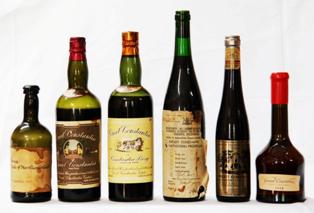The iconic sweet wines of Constantia
Saturday, September 27th, 2014
Constantia is acknowledged as the cradle of winemaking in South Africa, which makes Groot Constantia Estate the grand daddy. The well-preserved property dates back to 1685 and is of significant cultural and historical importance. The story of the legendary sweet wines of Constantia, once known as Constantia Wyn (Afrikaans for wine), is interwoven with that of the valley. It was first owned by Governor Simon van der Stel, whose stately Cape Dutch manor house is a national treasure today.
In the 18th and 19th centuries, the Constantia valley was known worldwide for its legendary dessert wines, which were drunk by aristocracy and royalty, from Bismarck to Frederick the Great, king of Prussia, and King Louis Philippe of France. Napoleon drank it on the island of St Helena to ease the solitude of his exile. The English prime minister, who had sampled is at Downing Street, ensured that regular consignments of this sweet wine from the Cape were delivered to Buckingham Palace for the king. These luscious dessert wines were also written about by Charles Dickens, Jane Austen and Baudelaire, among others.
The original Constantia Wyn was made by Van der Stel on Constantia in the late 1600s. In the 1720s, it was made by Johannes Colijn in the cellar at Hoop op Constantia, also to great acclaim. The cellar building still stands today – preserved but not in operation, it is used as a storeroom. The wines were later made in the Cloete Cellar, which still stands at Groot Constantia today (see below).
Simon van der Stel’s original Constantia farm was divided into three after his death in 1712: Constantia, which is Groot Constantia today, Klein Constantia (later Hoop op Constantia and once again part of Groot Constantia today) and Bergvliet. Buitenverwachting and Constantia Uitsig are situated on what was once a part of Bergvliet.
Boela Gerber, winemaker at Groot Constantia (incumbent since 2001), shared a few fascinating insights. He hypothesised that there were at least two different styles made in the Constantia sweet wines’ halcyon days of fame – a fortified version for overseas patrons and an unfortified version for local consumption. “Some were more Port-style wines, others Muscadel.” The original wines were probably made from Muscat, Pontac and maybe even Chenin Blanc, he speculated. Although Pontac is seriously difficult to grow here, he conceded.
Although it has long been held that no sweet wines were made after the devastating outbreak of Phylloxera decimated the Cape’s vineyards in the 1880s, Gerber insists this is untrue. Delving into the history of the estate, he’s found that sweet Constantia wines were made throughout the decades, albeit it only in small quantities.
Constantia wine was on the menu for a lunch in honour of the Duke and Duchess of Connaught and the Princess Patricia held on 1 November 1910 at Groot Constantia, as this fascinating excerpt (part 1 / part 2) from Jose Burman’s book Wine of Constantia shows.
Over the decades many old bottles have been unearthed on the estate. The photograph below shows a bottle dated 1821 and bearing the Grand Constance name.
The line-up of bottles on the farm (below, left to right) shows a 1791 Sweet Constantia from the Duke of Northumberland’s cellar; a 1926 sweet Constantia; a 1929 Constantiaberg liqueur wine; an experimental wine, a 1974 natural sweet wine from Muscat de Frontignan from Groot Constantia grapes made at Nietvoorbij, probably an early attempt to revive the sweet Constantia wines, according to Gerber, who tasted this wine a few years ago and found it “spectacular”; a noble late harvest from 1984 (he is unsure of the variety); and the current shape of the bottle.

According to Burman there was no sweet wine made in the 1940s and 1950s. Mnr Badenhorst (Swartland winemaker Adi Badenhorst of AA Badenhorst Family Wines’ grandpa, Oom Japie) replanted the farm in the late 1950s/early 1960s, mainly to Cabernet and Shiraz. In 1963, the committee presiding over Groot Constantia started to investigate the revival of the famous sweet Constantia wines. There is a brief reference of a small quantity of Frontignan that was produced, as well as the above-mentioned vintage 1974 made at Nietvoorbij. “By the way, apparently the 1791 Sweet Constantia from the Duke of Northumberland’s cellar has an alcohol of 22.3%. Maybe not so natural sweet?” concluded Gerber, giving substance to the point he made earlier regarding fortified wines.
Klein Constantia Estate reclaimed the world’s attention to the tradition of producing sweet wines in the valley with the launch of the acclaimed Vin de Constance 1986. A recreation of the original wines, it is made from unbotrytised Muscat de Frontignan.
Klein Constantia was separated from Groot Constantia in 1823. In 1980, Cape Town businessman Duggie Jooste bought the property. He consulted renowned viticulturist Professor Chris Orffer of Stellenbosch University during the redevelopment of the estate. They studied early records and planted Muscat de Frontignan in 1982. Since its launch, Vin de Constance has consistently appeared on lists of the world’s top wines. The 2007 vintage was awarded 97 points by Neal Martin of Robert Parker’s Wine Advocate, making it the best rated South African sweet wine in history.
In 2003, Groot Constantia revived Grand Constance, an internationally highly rated natural sweet made from both white and red Muscat de Frontignan (unlike the Vin de Constance, which is made only of white).
Buitenverwachting‘s take on the classic Constantia wines is the 1769 Muscat de Frontignan, also made from white-wine grapes only. The maiden vintage 2006 was rated a Platter four-and-a-half star wine in the 2009 guide – and that before it had even been named! The 2010 guide went on to rate the 2007 vintage five stars.
No visit to Constantia is complete without sampling at least one of these modern examples of the iconic sweet wines of the valley.
– Lindsaye Mc Gregor